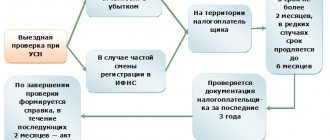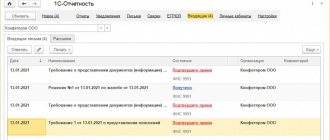Tax burden calculation
To calculate NV you need to perform the following steps:
- Determine the total amount of taxes and fees accrued for the calendar year according to declarations submitted to the Federal Tax Service.
- Take the revenue indicator from the Profit and Loss Statement for the same period.
- Divide item 1 by item 2, multiply the resulting quotient by 100%.
The obtained value must be compared with the industry indicator of taxable income, published annually by the Federal Tax Service. If the organization’s workload turns out to be lower than according to the Federal Tax Service, this may be a reason for inspection.
How to calculate the tax burden
The load is calculated as a percentage separately for each year using the formula:
Tax burden = ((Amount of accrued taxes for the year)/(Amount of revenue for the year))?100%
For the calculation, it is the taxes accrued and not paid for the year that are taken. This is because the accrual can be in one year, and the payment goes to the next. If you count by payment, the load may turn out to be less than it actually is.
Data on accrued taxes must be taken from declarations.
Taxes that are assessed as a tax agent, for example, personal income tax, are also taken into account. But insurance premiums for employees are not included in the calculation.
The amount of the organization’s revenue is taken from line 2110 “Revenue” of the annual report on financial results.
Entrepreneurs take revenue (income) from the 3-NDFL declaration or according to the simplified tax system.
The tax office can separately check the income tax burden. It is calculated according to the formula:
Income tax burden = ((Amount of accrued income tax)/(Amount of revenue and non-operating income))? 100%
The data must be taken from the income tax return.
Take a survey on the likelihood of a tax audit
Low tax burden
Let's consider an explanation (example), taking as a basis an educational organization that provides additional education services (OKVED 85.11).
The amount of accrued taxes for 2021 is 2,169,066 rubles.
Revenue for 2021 according to the income statement is 20,557,770 rubles.
NI will be 10.6% (2,169,066 / 20,557,770 × 100%).
We compare the resulting tax value with the corresponding indicator in the Federal Tax Service document “Tax burden by type of economic activity in percent” for 2021. In the Federal Tax Service document, the indicators are presented in aggregate; you need to find your section according to the OKVED classifier, and if it is not there, then use the NN value in the “Total” line.
The Federal Tax Service did not highlight the “Education” section; we compare the organization’s tax return with the general indicator in the “Total” line, which for 2021 is 10.8%.
The organization’s NI is 0.2% below the average (10.8–10.6%). If there are higher deviations of the organization's tax base from the industry average, the Federal Tax Service usually sends a letter with a recommendation to revise the tax base and pay additional taxes.
In this case, you will have to prepare an updated declaration explaining how the low tax burden arose; an explanation (see sample below) is attached to the updated declaration. The form of the explanatory note is given in Appendix No. 5 to the Order of the Federal Tax Service of Russia dated May 30, 2007 No. MM-3-06 / [email protected]
Low tax burden, what to say to the tax authorities
In order to replenish the state budget, the Federal Tax Service analyzes the calculation of the tax base by organizations.
In cases where a low tax burden is identified, the taxpayer is sent a request for clarification.
Is this legal? Is it possible to ignore the requirements of the Federal Tax Service and not submit an explanation of the low tax burden, a sample of which is posted below. Let's take a closer look at this issue.
The tax burden is determined by type of OKVED and denotes the percentage ratio of taxes paid and income received as a result of business activities. The indicators are calculated by tax authorities for the year using a special method. The data is given in Appendix No. 3 to the Order.
If, when analyzing the financial indicators of an enterprise, minimization of tax liabilities is revealed, significant deviations from the average statistical data are found, employees of the Federal Tax Service may decide on the need to conduct an on-site audit. But first, the taxpayer is sent a request to provide explanations.
How to competently justify the reasons for a low tax burden?
Reasons for low tax burden - explanation
Before you start drawing up explanations, check the level of your fiscal burden yourself. To do this, specify the OKVED code, calculate the total amount of taxes for the year, taking into account personal income tax, and calculate the specific percentage of personal income in relation to annual income.
When comparing data on individual taxes and payments, study the indicators from Appendix No. 2 to the Order, which indicates the criteria for assessing the low load in terms of deductions for VAT, personnel wages, unified agricultural tax, simplified tax system, UTII, personal income tax on business income, profitability of activities, etc. .
Low tax burden - explanation, example
There is no unified form for submitting explanations regarding the fact of low NV. The taxpayer may draw up a document in writing in any form. The main thing is to describe the reasons for the insufficient profitability of the enterprise or unprofitable activities, and, accordingly, the low volume of fiscal payments.
For example, the reason for the high share of VAT deductions for wholesale trade enterprises should be sought in an increase in warehouse goods or a decrease in sales; and for manufacturing organizations, one can reasonably cite an increase in purchase prices for inventories.
The actual reason is indicated in the explanatory note, taking into account the specifics of the company’s activities.
If you present the information correctly, you can avoid including the organization in the audit plan, but repeated deliberate understatement of the taxable income will sooner or later attract increased attention from tax authorities.
After filing a tax return, it is checked by specialists. The information contained in the document may raise questions. In particular, the low tax burden is suspicious. If the tax authorities have any questions, you will have to provide explanations.
Reasons for low tax burden: explanation
In some cases, situations are possible when an organization objectively bears tax burden below the industry average and does not have the opportunity to recalculate taxes upward.
The reasons for a decrease in the tax base may be an increase in expenses, a decrease in revenue, writing off large amounts of doubtful debts, production downtime or force majeure.
In this case, the Federal Tax Service should provide explanations as to why the amount of deductions is lower than the calculated value.
The document is drawn up in free form and can be titled as Statement, Information, Message or Explanatory Note.
Explanations to the tax office about the low tax burden can be formulated in this way.
Why a low tax burden is dangerous and how to reduce the risk of audits
In Russian practice, the term “tax burden” (TN) began to be used in 2007, when Order of the Federal Tax Service of Russia dated May 30, 2007 No. MM-3-06/ [email protected] (as amended on May 10, 2012) “On approval Concepts of a planning system for on-site tax audits.” The mentioned Order defines 12 criteria for taxpayers to independently assess the risk of an audit by the Federal Tax Service. And the first of them is the assessment of TN - the ratio of the amount of taxes and fees according to the Federal Tax Service to the organization’s revenue according to Goskomstat, expressed as a percentage. The calculation is made for the calendar year.
Every year, the Federal Tax Service publishes tax return indicators by type of activity, and if this indicator in an organization is lower than the industry indicator, then the risk of inspection by the Federal Tax Service inspector increases.
Bank checks
Banks monitor the minimum tax indicator, the value of which is set at 0.5% of receipts to the current account by the Methodological Recommendations, approved. Bank of Russia 04/13/2016 No. 10-MR.
If the total amount of payments for taxes, fees and charges is less, the bank may request explanations, declarations, financial statements, contracts and other documents.
It is also recommended to accompany the submission of documents to the bank with an explanatory note explaining the situation.
This is what an explanation about a low tax burden might look like: a sample for a bank.
Low tax burden for income tax: sample explanation
Sometimes, when submitting a declaration, situations arise in which the tax authorities have questions. They are often interested in the emergence of a low tax burden for income tax.
It is necessary to understand the reasons for its occurrence and the explanations that must be given to the tax service.
Contents The law clearly states that a tax officer has the right to request an explanatory note for the submitted declaration.
This need arises in case of suspicion that the tax amount is significantly underestimated. This may mean that the taxpayer is hiding his income from the state. Another reason is considered to be incorrect filling out of the declaration and making mistakes.
A decrease in business turnover, sales volumes, and salary increases also have a strong impact.
The tax office can request an explanatory note only in cases provided for by law. These are on-site or desk checks.
Otherwise, such a requirement is considered a violation of the law.
But we must remember that there are no specific requirements or explanations in the law about reducing the tax burden, but it is better for the company to provide an explanation.
In this case, checks can be avoided. In order to know how to give explanations to the declaration, you need to understand what the tax burden is. This is the ratio of the amount of taxes that an organization pays to the profit that is indicated in the documents, expressed as a percentage: Low is the load that is below the average in a given industry.
What are the reasons for the reduced load?
The explanatory note is provided to the tax office either in person or by mail. It is drawn up in free form. The entrepreneur’s task is to explain that the reduction in load was not special. To confirm your position, you need to provide a list of reasons for what happened. For example, these reasons could be:
Recommendations for writing an explanatory note:
If the tax office requests a note, it is recommended to send an explanatory note within 5 days. Otherwise, you will have to face verification.
What to do if there are errors in the declaration
A reduced load may also arise because errors were made in the declaration. In this case, you need to send updated information. Let's look at common errors and their codes:
If the error does not affect the tax burden indicator, the correct option is simply stated in the explanation. It is also required to indicate that the error did not cause an understatement. An alternative option is to submit an amended declaration. If an error caused an underestimation of the load, you need to draw up and send an updated declaration as soon as possible.
An updated declaration is a table containing credentials and details. In the lines with these registers, it is necessary to explain previously made distortions. The document specifies all areas of the company’s activities.
Each sheet must contain details of the legal entity. Some sheets require certification in the form of a signature from a representative of the organization.
We are preparing clarifications to the Federal Tax Service on reducing the tax burden and the high share of VAT deductions
The article from the magazine “MAIN BOOK” is relevant as of October 2, 2015. A.Yu.
Nikitin, certified tax consultant In the article, we told you how to independently control certain criteria by which tax authorities select candidates for GNP. Now let's talk about how to prepare explanations that can help fight off an invitation to a commission on the legalization of taxable objects and from a possible on-site inspection in the near future if the company does come under the close attention of inspectors.
Here are examples of such explanations. If you are in a risk zone based on the criterion of low tax burden and the inspectorate wants you to provide an explanation, you can do it something like this. Inspectorate of the Federal Tax Service of Russia for the city of Noginsk, Moscow region from Slobodka LLC, INN/KPP 5031543286/503101001, OGRN 1065031024923, tel. Contact person: Ch.
accountant I.A. Loyal Ref. No. 08-09/20 of 08/25/2015 To No. 04-16/11827 of 08/17/2015 The organization in its income tax return for 2014 did not allow incomplete reflection of information or errors that would lead to an understatement of the tax base and incomplete payment taxes.
In this regard, the organization has no obligation to clarify tax obligations for the specified period (clause 1 of Article 81 of the Tax Code of the Russian Federation). Tax burden on the main type of activity of the organization (
"Production of clothing from textile materials and clothing accessories"
, OKVED code 18.2) in 2014
amounted to 5.6%, which is below the industry average - 8.1% according to Appendix No. 3 to the Order of the Federal Tax Service dated May 30, 2007 No.







